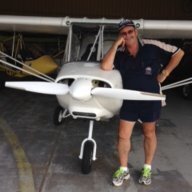David
You will be taught all of this before you set out on your Navs. Probably best to not overcook it because there are more than one way to skin a cat but your school will have their way. So listen in on the briefings and practice. When I was planning my Navs I ran my Wind, Bearings, Times, Fuel Weights every day from when I got given the route until I had finished the flight. One of my Navs I fully planned every day for 4 weeks due to weather cancellations etc. When you start doing that you get the hang of it fairly quickly, especially if every 2nd or 3rd one you can email to someone you trust, (an instructor preferably) to keep an eye on your number crunching. After all there is not a lot of point practicing the wrong thing.
As for getting accurate figures for my own plane it has been an interesting exercise. I am actually still not sure of my full endurance.
I have recorded every bit of fuel to go into her since first flight.
She has now done 44.7 hours and used 700 litres.
So I have an average of 15.67 litres/hour. Would I use that figure for planning purposes, not yet I wouldn't I want a far bigger sample than that.
I still plan using the POH figure of 20 l/h even though having crunched my numbers even my worst figure is still 2 l/h below that.
Maybe when I have a couple of hundred hours in different conditions I may consider using the actual figures for planning but still unlikely.
With an 80 litre tank and 75 litres useable (the book actually says 80 is usable and I have run the fuel pump with the tail on the ground and nose in the air and pumped the tank dry but I will keep my little non usable figure anyway).
That gives me 3 hours plus fixed reserve plus those extra 6 to 12 litres that I haven't burned yet.
I can live with that. If I want to go further I can carry 15 kgs of luggage or (2 by 10 litre cans). To date I have not yet landed her with less than 35 litres.
The added bonus with the Hanuman is that I just need to turn my head and I can see exactly how much is in the tank.





